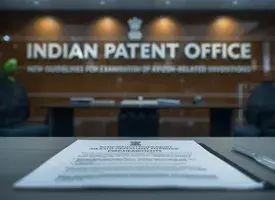By Swaraj Singh Raghuvanshi and Nishu Aditya
The Indian Patent Office (IPO) has recently issued its “Guidelines for Examination of AYUSH Related Inventions, 2025”, marking a milestone in the intersection of traditional knowledge and modern intellectual property rights. These guidelines aim to clarify the filing, examination, and grant of patents in areas involving Ayurveda, Yoga & Naturopathy, Unani, Siddha, Sowa-Rigpa, and Homoeopathy (collectively known as AYUSH).
Why These Guidelines?
India is home to one of the richest repositories of traditional medicine and bio-resources. As AYUSH products, nutraceuticals, and wellness solutions gain global traction, clear IP protection frameworks are necessary. The new guidelines:
- Prevent misappropriation of traditional knowledge.
- Encourage genuine innovation in AYUSH research and product development.
- Provide examiners with consistent criteria for assessment.
Legal Framework
Patent Applications in AYUSH must comply with
| Relevant Law | Key Requirement | Implications |
| Patents Act, 1970 | Defines patentability: novelty, inventive step, industrial applicability | Applications may be refused if the claims fall under statutory exclusions, such as non-patentable subject matter under Section 3 of the Patents Act — including Section 3(d) (new forms of known substances without enhanced efficacy), Section 3(e) (mere admixtures showing only aggregated properties), and Section 3(p) (inventions based on traditional knowledge or duplication of known properties). |
| Patents Rules, 2003 | Procedural compliance for filing, examination, and grant | Errors in compliance may delay or block grant |
| Biological Diversity Act, 2002 | Mandatory disclosure of source/origin of biological material | Wrong or incomplete disclosure may lead to refusal, opposition, or revocation |
Examination of AYUSH Applications
The IPO has outlined a structured process:
- Filing – By inventors, assignees, or legal representatives (online or at IPO offices).
- Screening & Classification – Categorization of subject matter and assigning classification codes by the Patent Office. Applications are published after 18 months (or within a month upon filing of early publication).
- Examination – The invention must meet the criteria of novelty, inventive step, and industrial applicability under the Patent Act, 1970. The Patent Office conducts a prior art search using databases like Traditional Knowledge Digital Library (TKDL) and AYUSH to assess compliance, especially for traditional knowledge systems.
- Assessment – The Patent Office checks whether the invention is new, inventive, and industrially applicable. For AYUSH inventions, this means the claims must go beyond what is already disclosed in traditional texts or the TKDL. Examiners look for genuine technical advancement, unexpected results (like synergistic effects), and proper disclosure of biological resources.
Six Guiding Principles for Patentability
The core of the guidelines lies in six guiding principles
| Principle | Patentable? | Example |
| 1. Extracts & Isolated Ingredients | Yes, if novel extraction process improves yield/purity | Extraction of berberine from leaves (process patentable) |
| 2. Combinations of Known Ingredients | Yes, if synergistic effect proven with data | Aloe vera + Calendula + Centella (obvious unless synergy shown) |
| 3. Known Ingredient in New Combinations | Presumed obvious unless unexpected effect shown | Cucumis melo extract + others for vitiligo |
| 4. Optimum/Workable Ranges | Yes, if unexpected technical results achieved | Adjusting herb ratios for wound healing |
| 5. Single Ingredient from Formulations | Generally not, if same therapeutic activity is known | Isolated Zingiber zerumbet for asthma |
| 6. AYUSH Devices & Equipment | Yes, if technical advancement shown | Automated device for Vamana Karma with sensors |
The Role of Synergism
The IPO stresses that synergistic effects must be backed by experimental data. Without this, multi-ingredient formulations risk being rejected under Section 3(e) as “mere admixtures.”
What counts as synergism?
When the combined therapeutic effect of ingredients is greater than the sum of their individual effects.
Example:
| Ingredient | Effect (Individual) | Combined Effect | Outcome |
| Tamarind Seed Polysaccharide | 40 pg/ml | ||
| Helichrysum italicum extract | 21 pg/ml | ||
| TSP + HIE (Combined) | 140 pg/ml | Synergistic- Patentable |
Resources for Applicants and Examiners
The guidelines recommend specific databases to validate novelty and identify traditional knowledge overlaps:
- TKDL – Traditional Knowledge Digital Library
- AYUSH Research Portal
- FRLHT Medicinal Plants Database
- e-Charak Portal
- Tribal Digital Document Repository
Practical Takeaways for Innovators
- Back claims with experimental data (especially for synergism).
- Comply with biodiversity laws — disclose biological sources transparently.
- Focus on devices, processes, and technological improvements, which may have higher chances of being patentable than formulations alone.
- Conduct prior art searches in TKDL and AYUSH repositories before filing.
Conclusion
The AYUSH Guidelines (2025) provide a clear framework for innovators, examiners, and industry stakeholders. By setting out guiding principles, emphasizing the role of synergism, and reinforcing compliance with biodiversity laws, the Indian Patent Office has struck a careful balance between protecting traditional knowledge and promoting modern innovation.
For AYUSH businesses, startups, and research institutions, this is the right time to align R&D with IP strategies and secure competitive advantages in the growing global wellness and healthcare market.


